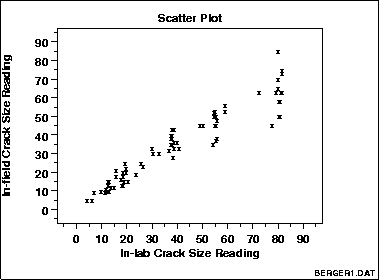1.3. EDA Techniques
1.3.3. Graphical Techniques: Alphabetic
1.3.3.26. |
Scatter Plot |
Check for Relationship
Linear Relationship Between Variables Y and X

This sample plot of the Alaska pipeline data reveals a linear relationship between the two variables indicating that a linear regression model might be appropriate.
Y Versus X
- Vertical axis: variable Y--usually the response variable
- Horizontal axis: variable X--usually some variable we suspect may ber related to the response
- Are variables X and Y related?
- Are variables X and Y linearly related?
- Are variables X and Y non-linearly related?
- Does the variation in Y change depending on X?
- Are there outliers?
- No relationship
- Strong linear (positive correlation)
- Strong linear (negative correlation)
- Exact linear (positive correlation)
- Quadratic relationship
- Exponential relationship
- Sinusoidal relationship (damped)
- Variation of Y doesn't depend on X (homoscedastic)
- Variation of Y does depend on X (heteroscedastic)
- Outlier
The scatterplot matrix generates all pairwise scatter plots on a single page. The conditioning plot, also called a co-plot or subset plot, generates scatter plots of Y versus X dependent on the value of a third variable.
causality implies association
association does NOT imply causality.
- some plot character (e.g., X) at the data points, and
- no line connecting data points.
Other scatter plot format variants include
- an optional plot character (e.g, X) at the data points, but
- a solid line connecting data points.
In both cases, the resulting plot is referred to as a scatter plot, although the former (discrete and disconnected) is the author's personal preference since nothing makes it onto the screen except the data--there are no interpolative artifacts to bias the interpretation.
Box Plot
Block Plot

